Yoghurtology Case Study: Porter's Five Forces and Macro Factors
VerifiedAdded on 2023/01/17
|9
|1864
|35
Case Study
AI Summary
This case study analyzes 'Yoghurtology,' a frozen yogurt shop in Birmingham, owned by partners Frank Jones and Peter Jackson. The report begins by exploring different types of business organizations, highlighting the advantages and disadvantages of sole proprietorships, partnerships, and corporations, with a focus on the partnership structure of Yoghurtology. It then applies Porter's Five Forces model to assess the competitive landscape, examining factors such as competition, potential new entrants, supplier power, customer power, and the threat of substitute products. The analysis emphasizes the need for Yoghurtology to maintain a competitive edge by introducing new flavors and healthy ingredients. Furthermore, the study investigates macro-environmental factors including demographics, socio-culture, and technology, and their impact on the business's operations and marketing strategies. The conclusion summarizes the key findings, emphasizing the importance of adapting to market trends and customer preferences to enhance profitability and achieve long-term sustainability. The report recommends that Yoghurtology focus on offering healthier options and leveraging technology for advertising to attract a wider customer base.
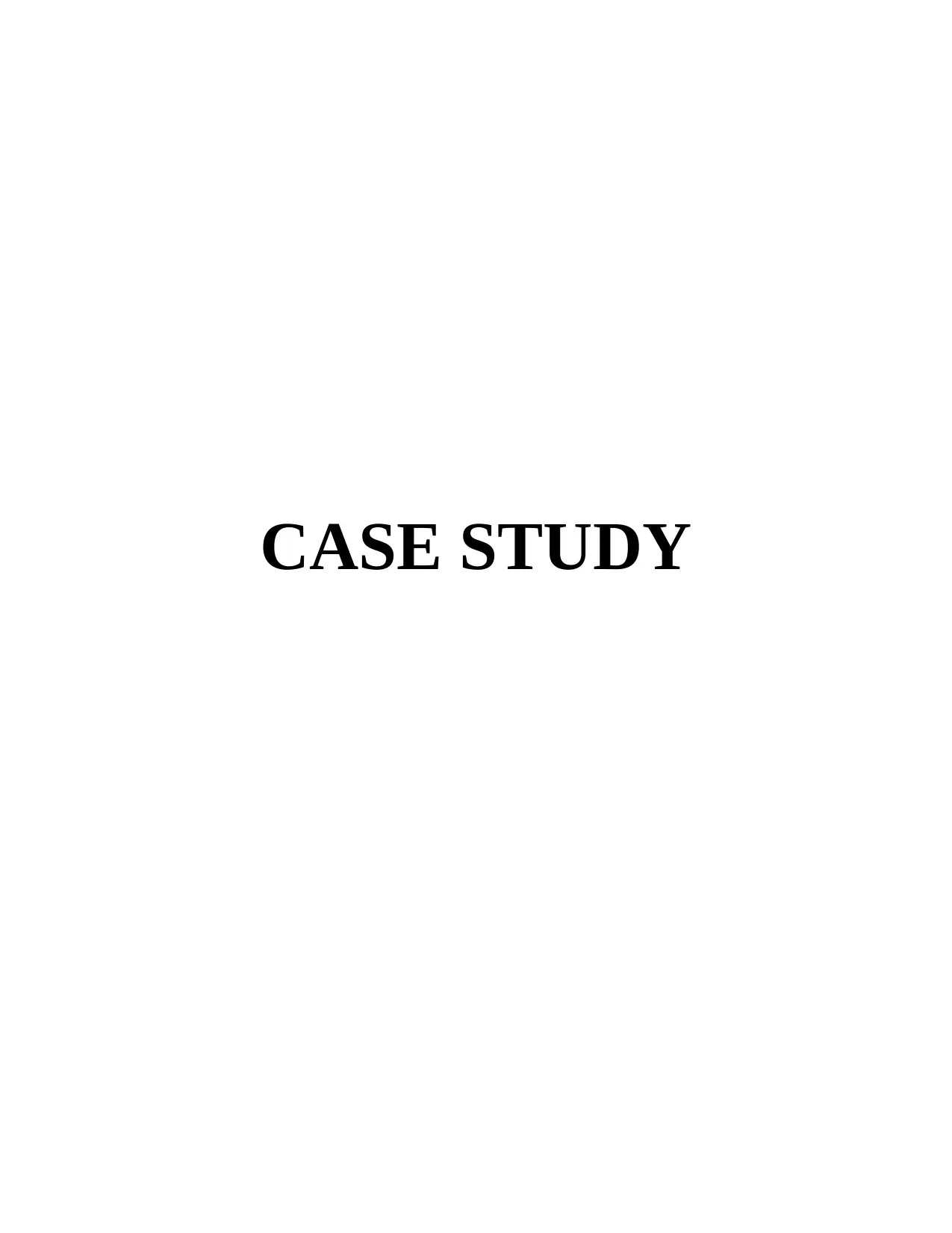
CASE STUDY
Paraphrase This Document
Need a fresh take? Get an instant paraphrase of this document with our AI Paraphraser
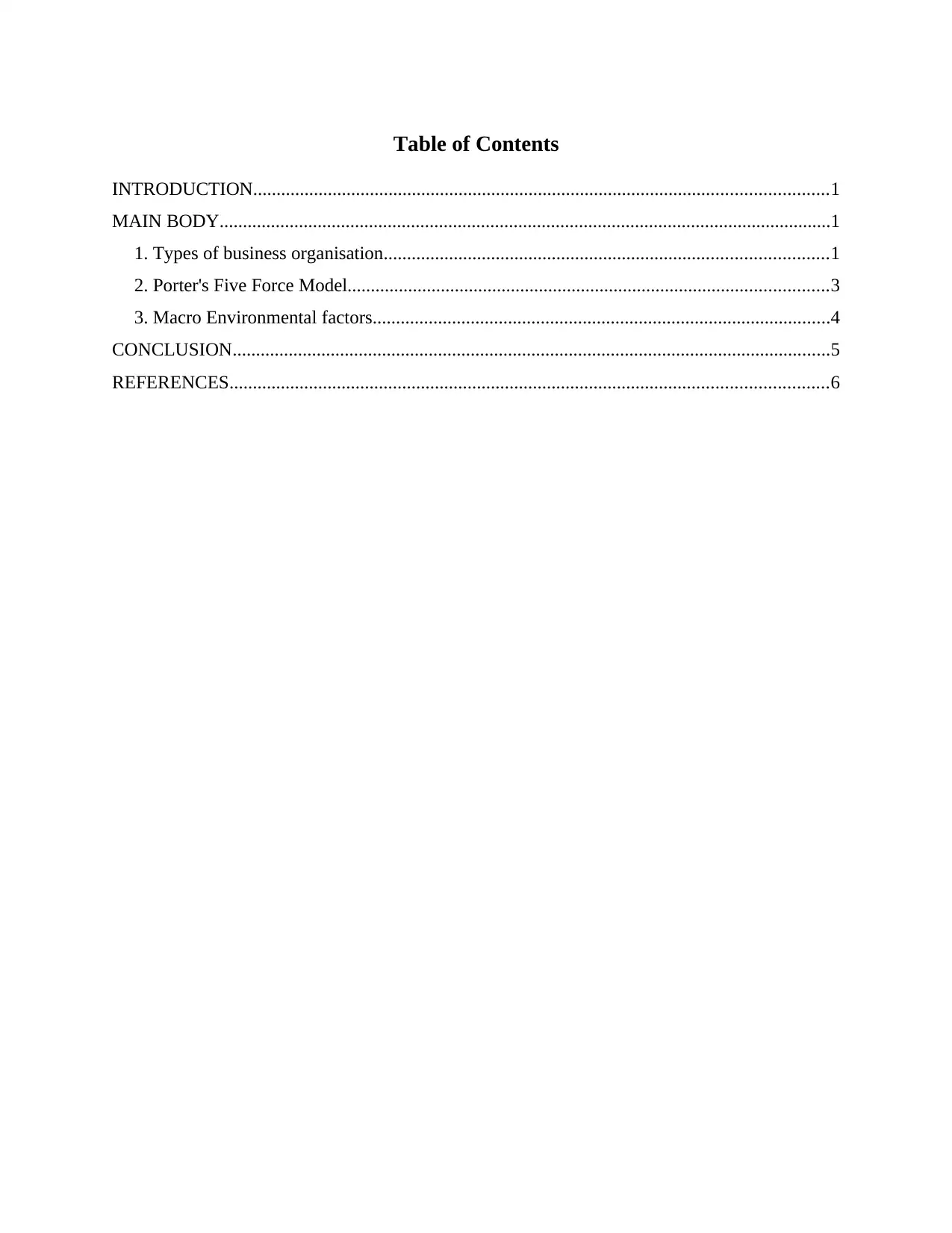
Table of Contents
INTRODUCTION...........................................................................................................................1
MAIN BODY...................................................................................................................................1
1. Types of business organisation...............................................................................................1
2. Porter's Five Force Model.......................................................................................................3
3. Macro Environmental factors..................................................................................................4
CONCLUSION................................................................................................................................5
REFERENCES................................................................................................................................6
INTRODUCTION...........................................................................................................................1
MAIN BODY...................................................................................................................................1
1. Types of business organisation...............................................................................................1
2. Porter's Five Force Model.......................................................................................................3
3. Macro Environmental factors..................................................................................................4
CONCLUSION................................................................................................................................5
REFERENCES................................................................................................................................6
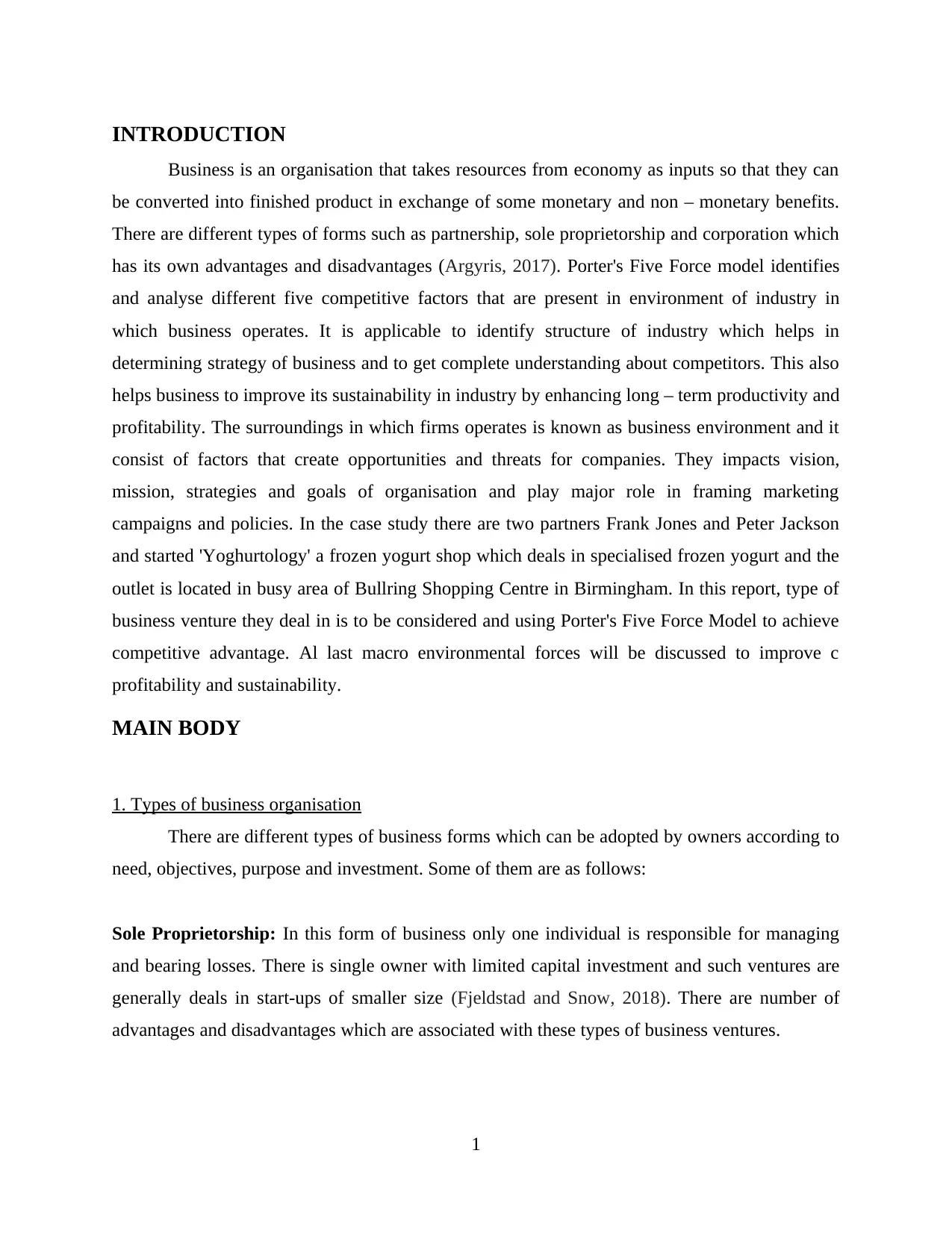
INTRODUCTION
Business is an organisation that takes resources from economy as inputs so that they can
be converted into finished product in exchange of some monetary and non – monetary benefits.
There are different types of forms such as partnership, sole proprietorship and corporation which
has its own advantages and disadvantages (Argyris, 2017). Porter's Five Force model identifies
and analyse different five competitive factors that are present in environment of industry in
which business operates. It is applicable to identify structure of industry which helps in
determining strategy of business and to get complete understanding about competitors. This also
helps business to improve its sustainability in industry by enhancing long – term productivity and
profitability. The surroundings in which firms operates is known as business environment and it
consist of factors that create opportunities and threats for companies. They impacts vision,
mission, strategies and goals of organisation and play major role in framing marketing
campaigns and policies. In the case study there are two partners Frank Jones and Peter Jackson
and started 'Yoghurtology' a frozen yogurt shop which deals in specialised frozen yogurt and the
outlet is located in busy area of Bullring Shopping Centre in Birmingham. In this report, type of
business venture they deal in is to be considered and using Porter's Five Force Model to achieve
competitive advantage. Al last macro environmental forces will be discussed to improve c
profitability and sustainability.
MAIN BODY
1. Types of business organisation
There are different types of business forms which can be adopted by owners according to
need, objectives, purpose and investment. Some of them are as follows:
Sole Proprietorship: In this form of business only one individual is responsible for managing
and bearing losses. There is single owner with limited capital investment and such ventures are
generally deals in start-ups of smaller size (Fjeldstad and Snow, 2018). There are number of
advantages and disadvantages which are associated with these types of business ventures.
1
Business is an organisation that takes resources from economy as inputs so that they can
be converted into finished product in exchange of some monetary and non – monetary benefits.
There are different types of forms such as partnership, sole proprietorship and corporation which
has its own advantages and disadvantages (Argyris, 2017). Porter's Five Force model identifies
and analyse different five competitive factors that are present in environment of industry in
which business operates. It is applicable to identify structure of industry which helps in
determining strategy of business and to get complete understanding about competitors. This also
helps business to improve its sustainability in industry by enhancing long – term productivity and
profitability. The surroundings in which firms operates is known as business environment and it
consist of factors that create opportunities and threats for companies. They impacts vision,
mission, strategies and goals of organisation and play major role in framing marketing
campaigns and policies. In the case study there are two partners Frank Jones and Peter Jackson
and started 'Yoghurtology' a frozen yogurt shop which deals in specialised frozen yogurt and the
outlet is located in busy area of Bullring Shopping Centre in Birmingham. In this report, type of
business venture they deal in is to be considered and using Porter's Five Force Model to achieve
competitive advantage. Al last macro environmental forces will be discussed to improve c
profitability and sustainability.
MAIN BODY
1. Types of business organisation
There are different types of business forms which can be adopted by owners according to
need, objectives, purpose and investment. Some of them are as follows:
Sole Proprietorship: In this form of business only one individual is responsible for managing
and bearing losses. There is single owner with limited capital investment and such ventures are
generally deals in start-ups of smaller size (Fjeldstad and Snow, 2018). There are number of
advantages and disadvantages which are associated with these types of business ventures.
1
⊘ This is a preview!⊘
Do you want full access?
Subscribe today to unlock all pages.

Trusted by 1+ million students worldwide
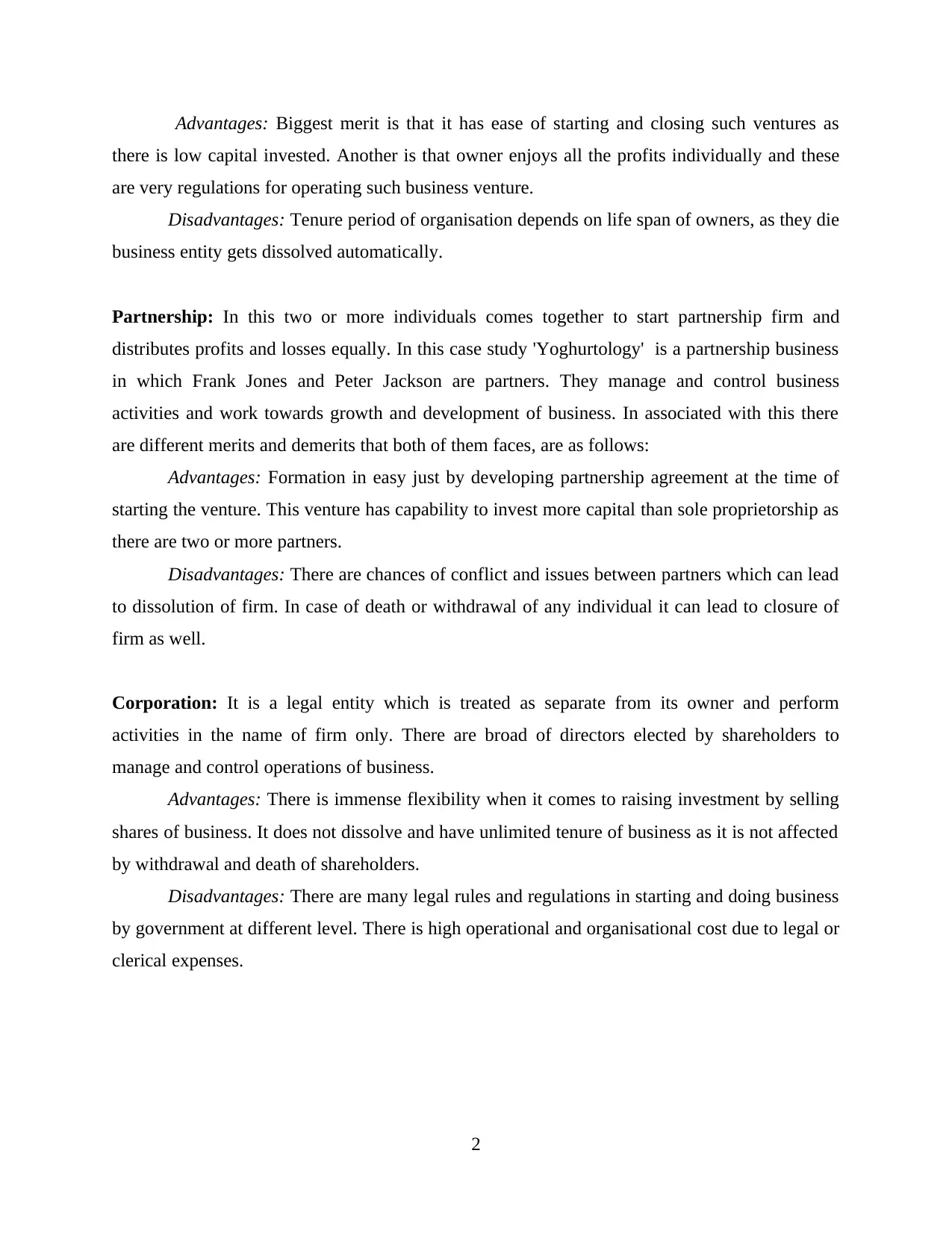
Advantages: Biggest merit is that it has ease of starting and closing such ventures as
there is low capital invested. Another is that owner enjoys all the profits individually and these
are very regulations for operating such business venture.
Disadvantages: Tenure period of organisation depends on life span of owners, as they die
business entity gets dissolved automatically.
Partnership: In this two or more individuals comes together to start partnership firm and
distributes profits and losses equally. In this case study 'Yoghurtology' is a partnership business
in which Frank Jones and Peter Jackson are partners. They manage and control business
activities and work towards growth and development of business. In associated with this there
are different merits and demerits that both of them faces, are as follows:
Advantages: Formation in easy just by developing partnership agreement at the time of
starting the venture. This venture has capability to invest more capital than sole proprietorship as
there are two or more partners.
Disadvantages: There are chances of conflict and issues between partners which can lead
to dissolution of firm. In case of death or withdrawal of any individual it can lead to closure of
firm as well.
Corporation: It is a legal entity which is treated as separate from its owner and perform
activities in the name of firm only. There are broad of directors elected by shareholders to
manage and control operations of business.
Advantages: There is immense flexibility when it comes to raising investment by selling
shares of business. It does not dissolve and have unlimited tenure of business as it is not affected
by withdrawal and death of shareholders.
Disadvantages: There are many legal rules and regulations in starting and doing business
by government at different level. There is high operational and organisational cost due to legal or
clerical expenses.
2
there is low capital invested. Another is that owner enjoys all the profits individually and these
are very regulations for operating such business venture.
Disadvantages: Tenure period of organisation depends on life span of owners, as they die
business entity gets dissolved automatically.
Partnership: In this two or more individuals comes together to start partnership firm and
distributes profits and losses equally. In this case study 'Yoghurtology' is a partnership business
in which Frank Jones and Peter Jackson are partners. They manage and control business
activities and work towards growth and development of business. In associated with this there
are different merits and demerits that both of them faces, are as follows:
Advantages: Formation in easy just by developing partnership agreement at the time of
starting the venture. This venture has capability to invest more capital than sole proprietorship as
there are two or more partners.
Disadvantages: There are chances of conflict and issues between partners which can lead
to dissolution of firm. In case of death or withdrawal of any individual it can lead to closure of
firm as well.
Corporation: It is a legal entity which is treated as separate from its owner and perform
activities in the name of firm only. There are broad of directors elected by shareholders to
manage and control operations of business.
Advantages: There is immense flexibility when it comes to raising investment by selling
shares of business. It does not dissolve and have unlimited tenure of business as it is not affected
by withdrawal and death of shareholders.
Disadvantages: There are many legal rules and regulations in starting and doing business
by government at different level. There is high operational and organisational cost due to legal or
clerical expenses.
2
Paraphrase This Document
Need a fresh take? Get an instant paraphrase of this document with our AI Paraphraser
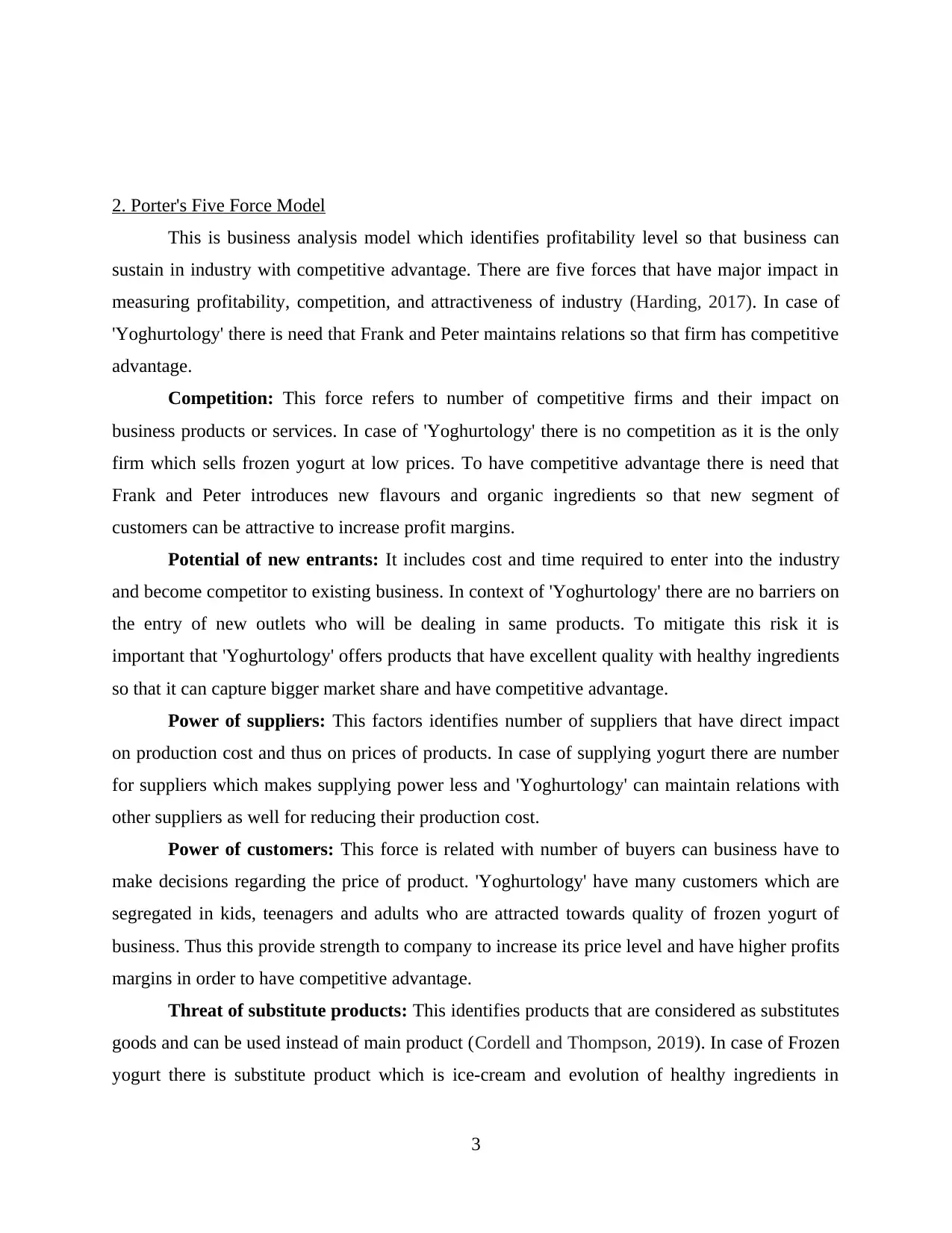
2. Porter's Five Force Model
This is business analysis model which identifies profitability level so that business can
sustain in industry with competitive advantage. There are five forces that have major impact in
measuring profitability, competition, and attractiveness of industry (Harding, 2017). In case of
'Yoghurtology' there is need that Frank and Peter maintains relations so that firm has competitive
advantage.
Competition: This force refers to number of competitive firms and their impact on
business products or services. In case of 'Yoghurtology' there is no competition as it is the only
firm which sells frozen yogurt at low prices. To have competitive advantage there is need that
Frank and Peter introduces new flavours and organic ingredients so that new segment of
customers can be attractive to increase profit margins.
Potential of new entrants: It includes cost and time required to enter into the industry
and become competitor to existing business. In context of 'Yoghurtology' there are no barriers on
the entry of new outlets who will be dealing in same products. To mitigate this risk it is
important that 'Yoghurtology' offers products that have excellent quality with healthy ingredients
so that it can capture bigger market share and have competitive advantage.
Power of suppliers: This factors identifies number of suppliers that have direct impact
on production cost and thus on prices of products. In case of supplying yogurt there are number
for suppliers which makes supplying power less and 'Yoghurtology' can maintain relations with
other suppliers as well for reducing their production cost.
Power of customers: This force is related with number of buyers can business have to
make decisions regarding the price of product. 'Yoghurtology' have many customers which are
segregated in kids, teenagers and adults who are attracted towards quality of frozen yogurt of
business. Thus this provide strength to company to increase its price level and have higher profits
margins in order to have competitive advantage.
Threat of substitute products: This identifies products that are considered as substitutes
goods and can be used instead of main product (Cordell and Thompson, 2019). In case of Frozen
yogurt there is substitute product which is ice-cream and evolution of healthy ingredients in
3
This is business analysis model which identifies profitability level so that business can
sustain in industry with competitive advantage. There are five forces that have major impact in
measuring profitability, competition, and attractiveness of industry (Harding, 2017). In case of
'Yoghurtology' there is need that Frank and Peter maintains relations so that firm has competitive
advantage.
Competition: This force refers to number of competitive firms and their impact on
business products or services. In case of 'Yoghurtology' there is no competition as it is the only
firm which sells frozen yogurt at low prices. To have competitive advantage there is need that
Frank and Peter introduces new flavours and organic ingredients so that new segment of
customers can be attractive to increase profit margins.
Potential of new entrants: It includes cost and time required to enter into the industry
and become competitor to existing business. In context of 'Yoghurtology' there are no barriers on
the entry of new outlets who will be dealing in same products. To mitigate this risk it is
important that 'Yoghurtology' offers products that have excellent quality with healthy ingredients
so that it can capture bigger market share and have competitive advantage.
Power of suppliers: This factors identifies number of suppliers that have direct impact
on production cost and thus on prices of products. In case of supplying yogurt there are number
for suppliers which makes supplying power less and 'Yoghurtology' can maintain relations with
other suppliers as well for reducing their production cost.
Power of customers: This force is related with number of buyers can business have to
make decisions regarding the price of product. 'Yoghurtology' have many customers which are
segregated in kids, teenagers and adults who are attracted towards quality of frozen yogurt of
business. Thus this provide strength to company to increase its price level and have higher profits
margins in order to have competitive advantage.
Threat of substitute products: This identifies products that are considered as substitutes
goods and can be used instead of main product (Cordell and Thompson, 2019). In case of Frozen
yogurt there is substitute product which is ice-cream and evolution of healthy ingredients in
3
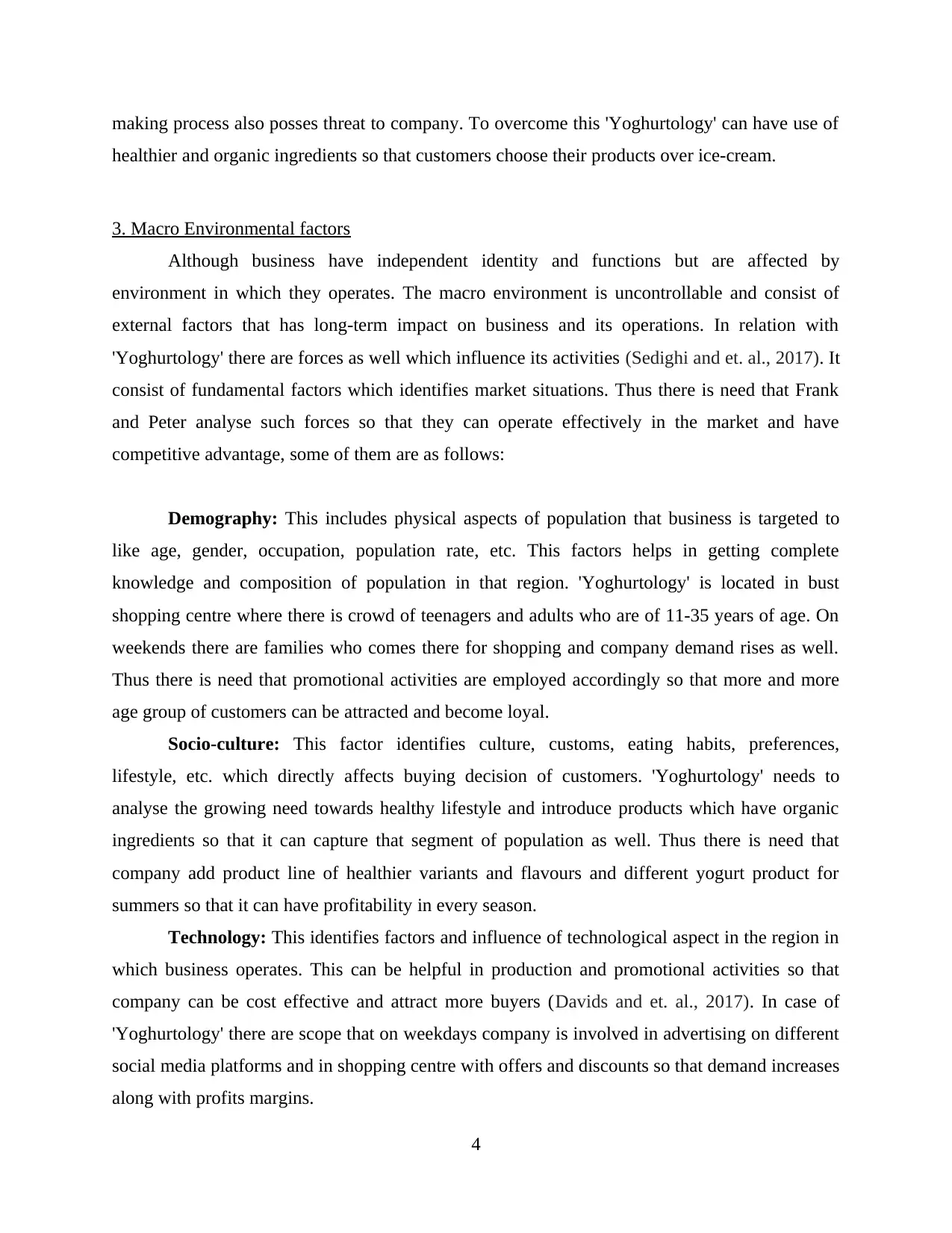
making process also posses threat to company. To overcome this 'Yoghurtology' can have use of
healthier and organic ingredients so that customers choose their products over ice-cream.
3. Macro Environmental factors
Although business have independent identity and functions but are affected by
environment in which they operates. The macro environment is uncontrollable and consist of
external factors that has long-term impact on business and its operations. In relation with
'Yoghurtology' there are forces as well which influence its activities (Sedighi and et. al., 2017). It
consist of fundamental factors which identifies market situations. Thus there is need that Frank
and Peter analyse such forces so that they can operate effectively in the market and have
competitive advantage, some of them are as follows:
Demography: This includes physical aspects of population that business is targeted to
like age, gender, occupation, population rate, etc. This factors helps in getting complete
knowledge and composition of population in that region. 'Yoghurtology' is located in bust
shopping centre where there is crowd of teenagers and adults who are of 11-35 years of age. On
weekends there are families who comes there for shopping and company demand rises as well.
Thus there is need that promotional activities are employed accordingly so that more and more
age group of customers can be attracted and become loyal.
Socio-culture: This factor identifies culture, customs, eating habits, preferences,
lifestyle, etc. which directly affects buying decision of customers. 'Yoghurtology' needs to
analyse the growing need towards healthy lifestyle and introduce products which have organic
ingredients so that it can capture that segment of population as well. Thus there is need that
company add product line of healthier variants and flavours and different yogurt product for
summers so that it can have profitability in every season.
Technology: This identifies factors and influence of technological aspect in the region in
which business operates. This can be helpful in production and promotional activities so that
company can be cost effective and attract more buyers (Davids and et. al., 2017). In case of
'Yoghurtology' there are scope that on weekdays company is involved in advertising on different
social media platforms and in shopping centre with offers and discounts so that demand increases
along with profits margins.
4
healthier and organic ingredients so that customers choose their products over ice-cream.
3. Macro Environmental factors
Although business have independent identity and functions but are affected by
environment in which they operates. The macro environment is uncontrollable and consist of
external factors that has long-term impact on business and its operations. In relation with
'Yoghurtology' there are forces as well which influence its activities (Sedighi and et. al., 2017). It
consist of fundamental factors which identifies market situations. Thus there is need that Frank
and Peter analyse such forces so that they can operate effectively in the market and have
competitive advantage, some of them are as follows:
Demography: This includes physical aspects of population that business is targeted to
like age, gender, occupation, population rate, etc. This factors helps in getting complete
knowledge and composition of population in that region. 'Yoghurtology' is located in bust
shopping centre where there is crowd of teenagers and adults who are of 11-35 years of age. On
weekends there are families who comes there for shopping and company demand rises as well.
Thus there is need that promotional activities are employed accordingly so that more and more
age group of customers can be attracted and become loyal.
Socio-culture: This factor identifies culture, customs, eating habits, preferences,
lifestyle, etc. which directly affects buying decision of customers. 'Yoghurtology' needs to
analyse the growing need towards healthy lifestyle and introduce products which have organic
ingredients so that it can capture that segment of population as well. Thus there is need that
company add product line of healthier variants and flavours and different yogurt product for
summers so that it can have profitability in every season.
Technology: This identifies factors and influence of technological aspect in the region in
which business operates. This can be helpful in production and promotional activities so that
company can be cost effective and attract more buyers (Davids and et. al., 2017). In case of
'Yoghurtology' there are scope that on weekdays company is involved in advertising on different
social media platforms and in shopping centre with offers and discounts so that demand increases
along with profits margins.
4
⊘ This is a preview!⊘
Do you want full access?
Subscribe today to unlock all pages.

Trusted by 1+ million students worldwide
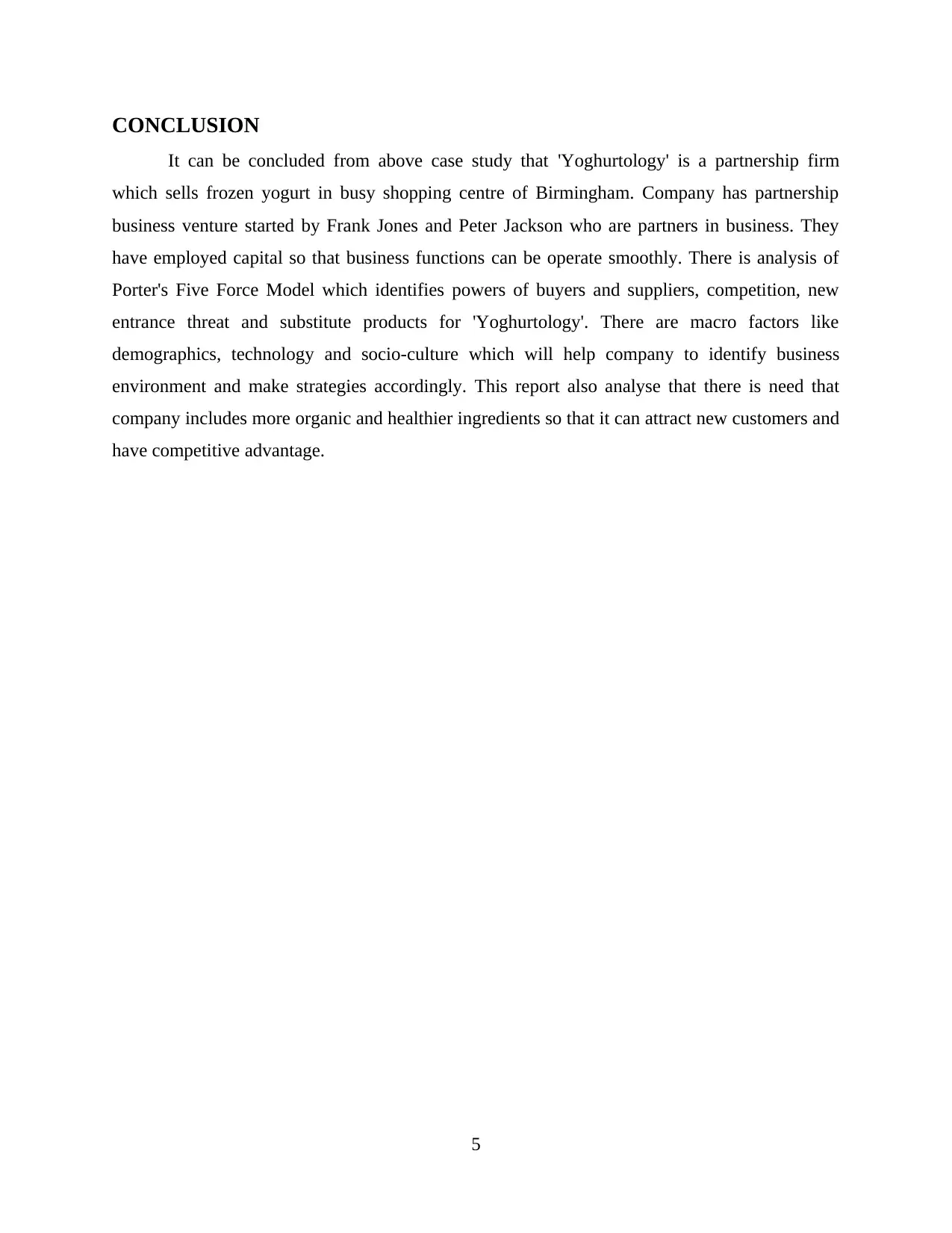
CONCLUSION
It can be concluded from above case study that 'Yoghurtology' is a partnership firm
which sells frozen yogurt in busy shopping centre of Birmingham. Company has partnership
business venture started by Frank Jones and Peter Jackson who are partners in business. They
have employed capital so that business functions can be operate smoothly. There is analysis of
Porter's Five Force Model which identifies powers of buyers and suppliers, competition, new
entrance threat and substitute products for 'Yoghurtology'. There are macro factors like
demographics, technology and socio-culture which will help company to identify business
environment and make strategies accordingly. This report also analyse that there is need that
company includes more organic and healthier ingredients so that it can attract new customers and
have competitive advantage.
5
It can be concluded from above case study that 'Yoghurtology' is a partnership firm
which sells frozen yogurt in busy shopping centre of Birmingham. Company has partnership
business venture started by Frank Jones and Peter Jackson who are partners in business. They
have employed capital so that business functions can be operate smoothly. There is analysis of
Porter's Five Force Model which identifies powers of buyers and suppliers, competition, new
entrance threat and substitute products for 'Yoghurtology'. There are macro factors like
demographics, technology and socio-culture which will help company to identify business
environment and make strategies accordingly. This report also analyse that there is need that
company includes more organic and healthier ingredients so that it can attract new customers and
have competitive advantage.
5
Paraphrase This Document
Need a fresh take? Get an instant paraphrase of this document with our AI Paraphraser
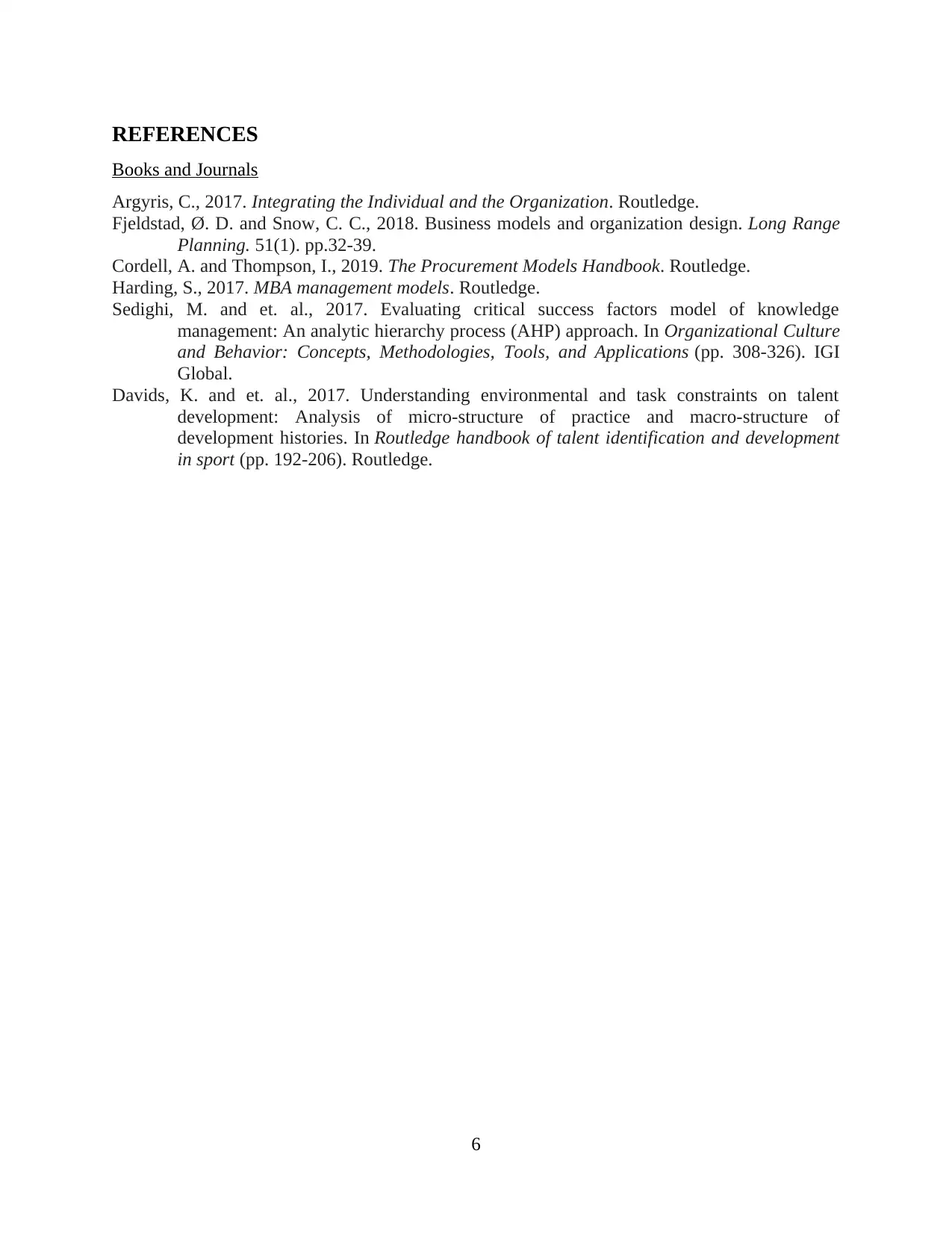
REFERENCES
Books and Journals
Argyris, C., 2017. Integrating the Individual and the Organization. Routledge.
Fjeldstad, Ø. D. and Snow, C. C., 2018. Business models and organization design. Long Range
Planning. 51(1). pp.32-39.
Cordell, A. and Thompson, I., 2019. The Procurement Models Handbook. Routledge.
Harding, S., 2017. MBA management models. Routledge.
Sedighi, M. and et. al., 2017. Evaluating critical success factors model of knowledge
management: An analytic hierarchy process (AHP) approach. In Organizational Culture
and Behavior: Concepts, Methodologies, Tools, and Applications (pp. 308-326). IGI
Global.
Davids, K. and et. al., 2017. Understanding environmental and task constraints on talent
development: Analysis of micro-structure of practice and macro-structure of
development histories. In Routledge handbook of talent identification and development
in sport (pp. 192-206). Routledge.
6
Books and Journals
Argyris, C., 2017. Integrating the Individual and the Organization. Routledge.
Fjeldstad, Ø. D. and Snow, C. C., 2018. Business models and organization design. Long Range
Planning. 51(1). pp.32-39.
Cordell, A. and Thompson, I., 2019. The Procurement Models Handbook. Routledge.
Harding, S., 2017. MBA management models. Routledge.
Sedighi, M. and et. al., 2017. Evaluating critical success factors model of knowledge
management: An analytic hierarchy process (AHP) approach. In Organizational Culture
and Behavior: Concepts, Methodologies, Tools, and Applications (pp. 308-326). IGI
Global.
Davids, K. and et. al., 2017. Understanding environmental and task constraints on talent
development: Analysis of micro-structure of practice and macro-structure of
development histories. In Routledge handbook of talent identification and development
in sport (pp. 192-206). Routledge.
6

7
⊘ This is a preview!⊘
Do you want full access?
Subscribe today to unlock all pages.

Trusted by 1+ million students worldwide
1 out of 9
Related Documents
Your All-in-One AI-Powered Toolkit for Academic Success.
+13062052269
info@desklib.com
Available 24*7 on WhatsApp / Email
![[object Object]](/_next/static/media/star-bottom.7253800d.svg)
Unlock your academic potential
Copyright © 2020–2025 A2Z Services. All Rights Reserved. Developed and managed by ZUCOL.




